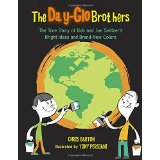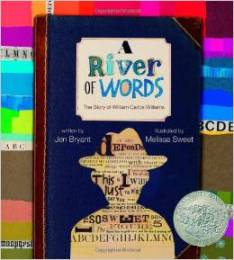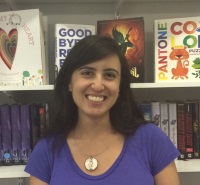I met Jenny Adams Perinovic, a fellow TGNA member, through Twitter when she was looking for unpublished writers to interview about their journey, thus far. That led to me auditioning for and joining the group blog, and now a few years and a some memorable Google hangouts later, I am happy to call her a friend. I am honored to have the privilege of interviewing her now that she is celebrating the release of her first book!
All of us at The Great Noveling Adventure are so thrilled for her and couldn’t be more excited.
First, a little bit about her novel:
The Book
A MAGIC DARK AND BRIGHT by Jenny Adams Perinovic
Release Date: April 28, 2015
Genres: YA, Gothic Romance
Order a Signed Paperback (US): One More Page Books
Order the eBook: Kindle (US) · Kindle (UK) · Nook · Kobo · Itunes
Order a Paperback: Amazon / B&N / The Book Depository / IndieBound
Plot Summary:
She meant to help a ghost…not unleash a curse.
Amelia Dupree hasn’t seen the Woman in White since the night her brother died.
The ghost seems to have disappeared from the woods surrounding Asylum, Pennsylvania—that is, until Charlie Blue moves into the creepy old MacAllister House next door. Amelia can’t help liking him, even though she spent her childhood thinking his grandmother was a witch. And she definitely can’t ignore the connection between his arrival and the Woman in White’s return.
Then Amelia learns that the Woman in White is a prisoner, trapped between the worlds of the living and the dead. Devastated by the idea that her brother could be suffering a similar fate, Amelia decides to do whatever it takes to help the Woman in White find peace–and Charlie agrees to help her.
But when Amelia’s classmates start to drown in the Susquehanna River, one right after another, rumors swirl as people begin to connect the timing of Charlie’s arrival with the unexplained deaths. As Charlie and Amelia uncover the dark history of Asylum, they realize they may have unleashed an unspeakable evil. One they have to stop before everything they love is destroyed.
_____________________________
Advance Praise: “A MAGIC DARK AND BRIGHT is a captivating mystery filled with magic and romance. It kept me enthralled until the heart-stopping finale.” — Lisa Maxwell, Author of SWEET UNREST
Doesn’t that just give you chills? I love a delicious gothic mystery with some tortured romance on the side. This sounds like my kind of story. I’m so excited to get my hands on this book! Let’s hear more about how this story came into being.
 The Interview
The Interview
Valerie Lawson: What was the inspiration for this project?
Jenny Adams Perinovic: Would you believe it started as a homework assignment? I completed a few courses towards my MA in Fiction at Johns Hopkins, and one of my first assignments was a short piece that told the story of a character from another character’s point of view. The first line came to me right away: Halfway through November, Charlie stopped coming to school. By the end of the assignment, I knew three things: the story was set in the mountains where I grew up, Charlie and Amelia had done a Bad Thing, and I could keep going in Amelia’s voice forever. SO MUCH has changed since then (including that first line!) but Charlie, Amelia, and Asylum have always been there.
VL: Thank goodness for that assignment. Who says all homework is bad, right?
I just love the title for this book, and that plot summary sounds amazing. I can’t wait to read it! What more can you tell us about this story?
JAP: Thank you so much! A MAGIC DARK AND BRIGHT is the story of a girl dealing with extreme loss–her brother, Mark, passed away shortly before the story starts and she blames herself for his death. They both knew that the woods behind their house were haunted by a mysterious woman in white, but after Mark’s death, the ghost stops appearing. Amelia becomes obsessed with watching the woods, and after several weeks, the ghost reappears, just as a pretty cute boy moves in next door. Amelia befriends Charlie, even though his grandmother is one of the most notorious citizens of their town. Things get complicated when the townspeople start to blame Charlie for a string of mysterious drownings, because everyone knows his family is Cursed with a capital C. I won’t get into TOO much more detail, but this is also a story about friendship and grief. And there’s magic. And kissing.
VL: People do crazy things when dealing with loss. Even before you throw in magic and cursed boys and kissing.
You took on the daunting process of self-publishing for the book. Tell us about that decision and why it was right for you, for this project. Did you have that goal in mind when you started out or did this evolve throughout your writing process?
JAP: It definitely evolved. When I started writing AMD&B in 2012, I didn’t know much about self-publishing, but as the years went on, it went from being a last resort to a really attractive option. I queried for a few months, but after doing a LOT of research and asking a ton of questions, I decided to pull it from consideration and dive into indie publishing.
VL: What surprised you the most about the process of putting a book out into the world yourself?
JAP: The support! I had expected a little bit of…not backlash, exactly, but maybe a little bit of snobbery about my decision? Self-publishing definitely has a stigma attached to it, because there are a lot of people out there who don’t treat it professionally. But everyone–from writer friends to family to my local community–has been so supportive and excited for me. It’s really amazing.
VL: That is so fantastic. Nothing feels better than the support of your loved ones and peers! It doesn’t hurt that you have painstakingly worked through each step of the publishing process to put out a quality book. I mean, that cover! So gorgeous!
Thinking back to your childhood, what heroes or role models did you look up to? What drew you to them?
JAP: Oh, this is a GOOD question. My first hero ever was Nancy Drew. When people asked me what I wanted to be when I grew up, I’d say, “Nancy Drew.” Now, clearly, I’m not a girl detective, but I think Nancy would approve of my career path. 😉 I was drawn to her smarts, her drive, and her strong relationships with Bess, George, and Ned.
VL: Oh, yes! I loved Nancy Drew.
Who was your childhood best friend? Are you still friends today?
JAP: I actually have three best friends from elementary school who, at this point, are more like sisters than friends. One of them is Sarah Kettles, another TGNA blogger and the most talented writer I know. I can’t imagine life without them!
VL: How wonderful! My closest friend is from my childhood, too. There’s nothing like someone who’s known you all your life (and sticks by your side anyway).
What was the worst job you ever had while going to school?
JAP: Oh, hands down was when I worked as a student web developer in college. I spent 20 hours a week turning syllabi into web pages, which wasn’t terrible, but I was also working 15 hours in the library and taking a full course load. And then I caught mono and BAM. I was done for. When I asked if I could reduce my hours to 10 a week, my boss told me I should drop a class or two, because “there’s no shame in graduating late.” I quit on the spot.
VL: How dreadful! What a thing to tell a student.
What are you currently working on?
JAP: Three things: the sequel to AMD&B, which is taking precedence; my circus book, which is pretty much the book of my heart; and the new adult mystery I started during NaNoWriMo.
VL: Oh, a circus book! That sounds interesting. Of course, after I start this book, I’ll want you to finish the sequel AMD&B book first. No pressure.
What has been your favorite book to read/book you’ve been most excited about over the past year?
JAP: I was most excited about ISLA AND THE HAPPILY EVER AFTER by Stephanie Perkins–I loved ANNA and LOLA and ISLA didn’t disappoint. I was also really looking forward to the latest OUTLANDER book, because Jamie Fraser.
On book I absolutely loved was called LOVE IN A TIME OF MONSTERS by Teresa Yea. I stumbled upon the cover on Pinterest and just KNEW I had read it. It was SO wonderful and clever and imaginative, and I couldn’t put it down.
VL: I really want to read that series from Stephanie Perkins. And so many other good recommendations there. Although, Outlander seems to come with an increase in my cable TV commitment, as well. Although from what all my writer friends say, totally worth it.
What would be your dream assignment/what would you most like to write about?
JAP: I’m dying to write a cheerleading book. Cheerleading was such a huge part of my life in high school, and I think a mystery set in the world of competitive cheer would be SO MUCH FUN. Like Veronica Mars meets Bring it On.
VL: That is an excellent comp title. I’m sure you would have a ton of interest in that story.
Thank you SO MUCH for sharing your beautiful new book with us, Jenny! I am thrilled for you, and wish your book a happy release day!
As a special treat to whet your appetites further for this book, here is an excerpt from A MAGIC DARK & BRIGHT:
Narrow stairs twisted up into the darkness. Charlie reached down and touched my wrist, urging me forward. My heart beat a frantic tattoo against my ribs; I wasn’t sure whether it was from his touch or nerves from the thought of heading up into the darkness.
I had the flashlight, so I went first. The stairs groaned under my weight, and I climbed slowly, focusing the yellow beam of light on the steps ahead of me until we reached the top and had nowhere else to go.
The rain was louder up here, pounding on the roof like an entire troop of tap-dancers. I swung the flashlight around, trying to get my bearings. The light danced over white-draped furniture, old-fashioned steamer trunks, and piles and piles of newspapers tied into neat bundles. The small rectangle of floor closest to the stairs was completely clear already. Lightning flashed, throwing the attic into such a bright light that I had to blink, and…
My breath caught in my throat. It couldn’t be. She never left the woods.
“What is it?” Charlie was right behind me.
I stepped closer, not trusting myself to speak. This time, with the flashlight focused solely on it, the silhouette of a dress form took shape, and I let out a shaky laugh, right as the thunder rolled overhead. “A dummy,” I said. “Just a dress dummy.”
“Did you think…?” He let the question trail off, and I shrugged. “Can you believe all of this stuff?” he asked.
I handed the flashlight back to him and lifted the corner of the sheet-covered lump next to me. An old rose-colored tufted sofa was underneath, a large rip in one of the cushions. “This all looks like…”
“Junk,” Charlie finished. “It’s all a bunch of junk.”
I plucked a large feathered hat from one of the piles closest to me and set it on my head. I posed in the dim light, fluttering my eyelashes at him. “Junk?” I pretended to be outraged, throwing one hand to my chest. “Why, Mr. Blue, how dare you? This here is one of the finest hats to ever grace this blessed Earth.”
He laughed. “I take it back,” he said. “That is a lovely hat.”
I stuck my tongue out at him, and he grinned. Feeling brave, I decided to venture deeper into the attic to see what else I could find. I’d only gone a few steps when I stepped on something that was definitely not floor. I gave a shriek as my feet went out from under me.
I threw out my arms, grabbing at the stack of boxes beside me, trying to keep my balance. That did nothing. In fact, I hit the ground in a heap, the boxes sliding down on top of me in a pile of dust and tiny plastic pieces.
Charlie was beside me in an instant. “Are you okay?”
“I think so,” I said, struggling to sit up. “Just clumsy.”
The boxes were all long and thin. Board game boxes. Some had opened in the fall; a cascade of faded Monopoly money and a few lonely pieces of Clue spilled across the floor. I pushed the boxes off me and stacked them neatly to one side.
Charlie leaned down to help me, tucking the flashlight under his arm. He picked up the pieces of the games on the floor and set them into the right boxes. “Look at these,” he said. “They’re ancient.”
I picked up a plain black box, almost the size and shape of the others, that hadn’t opened during the fall. I shook it gently. Something light rattled around. “I wonder what’s in here.”
He shone the flashlight on the box as I lifted the lid and set it aside. Nestled inside was a board covered in letters and a white triangle about the size of my palm. I picked the triangle up, running my fingers over the smooth, cool wood.
“Is that an Ouija board?” Charlie asked. He dropped to the floor beside me, sending up a cloud of dust. His long legs sprawled out, brushing against mine.
“I think so,” I answered. I pulled the board out and set it on the floor between us. “Leah and I tried this once.” It was one of my only clear memories of the days following Mark’s funeral: sitting in his bedroom, surrounded by his things, trying so hard to get him to speak to us. To me. “We couldn’t get it to work.” I turned the planchette over in my hands.
He locked his eyes with mine. His smile was slow and sweet, and it made my heart flip in my chest. “We could give it a try.”
“Now?” I couldn’t help the shiver that marched down my spine. Outside, the storm raged.
“What are you afraid of?” Charlie set the flashlight in his lap and reached over and plucked the planchette from my grip. He set it on the board, then looked up at me, his eyes dancing in the dim light.
Everything, I wanted to say. Instead, I scooted closer to him so my thigh pressed against his. “Fine,” I said, but I hesitated before putting my hand next to his on the planchette. Would I be able to handle it when it didn’t work?
Would I be able to handle it if it did?
Jenny is also giving away a SIGNED copy of her book and other swag on her website! Stop by to enter or clink on the link below!
ENTER HERE!!! ➤➤➤ Jenny’s Rafflecopter giveaway
Learn more about Jenny Adams Perinovic here.
Follow Jenny on Twitter here.
Follow Jenny on Facebook here.


 BRAVE ON THE PAGE; Oregon Writers on Craft and the Creative Life edited by
BRAVE ON THE PAGE; Oregon Writers on Craft and the Creative Life edited by 
 Rachel Orr, Literary Agent with the
Rachel Orr, Literary Agent with the 











 Laura Biagi, Literary Agent with the
Laura Biagi, Literary Agent with the  Kristine Brogno, Design Director for
Kristine Brogno, Design Director for 










 Erica Finkel, Associate Editor with
Erica Finkel, Associate Editor with 
























 If you like a challenge or need some company to help you write in the mornings, feel free to join me on Twitter every weekday. I host AM #wordsprints on Twitter
If you like a challenge or need some company to help you write in the mornings, feel free to join me on Twitter every weekday. I host AM #wordsprints on Twitter